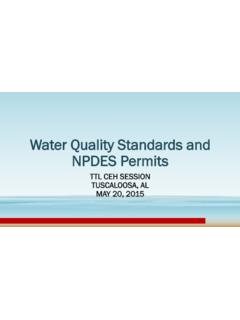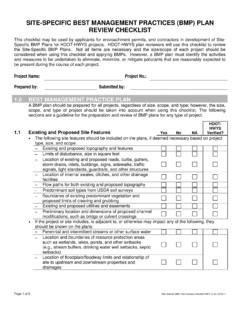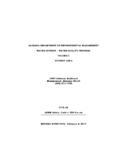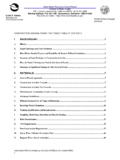Transcription of CHAPTER 3. Overview of the NPDES Permitting …
1 September 2010 NPDES permit Writers Manual CHAPTER 3: Overview of the NPDES Permitting process 3-1 CHAPTER 3. Overview of the NPDES Permitting process This CHAPTER presents an Overview of the different types of National Pollutant Discharge Elimination System ( NPDES ) permits, the major permit components, and the permit development and issuance process . The permit process is illustrated by flow charts. The tasks identified within the flow charts are described in detail in subsequent chapters. Types of Permits The two basic types of NPDES permits are individual and general permits. These permit types share the same components but are used under different circumstances and involve different permit issuance processes.
2 Individual Permits An individual permit is a permit specifically tailored to an individual facility. Upon receiving the appropriate application form(s), the Permitting authority develops a permit for that facility on the basis of information from the permit application and other sources ( , previous permit requirements, discharge monitoring reports, technology and water quality standards, total maximum daily loads, ambient water quality data, special studies). The Permitting authority then issues the permit to the facility for a specific period not to exceed 5 years, with a requirement to reapply before the expiration date. General Permits A Permitting authority develops and issues a general permit to cover multiple facilities in a specific category of discharges or of sludge use or disposal practices.
3 General permits can be a cost-effective option for agencies because of the large number of facilities that can be covered under a single permit . According to Title 40 of the Code of Federal Regulations (CFR) (a)(2), general permits may be written to cover stormwater point sources or other categories of point sources having the following common elements: Sources that involve the same or substantially similar types of operations. Sources that discharge the same types of wastes or engage in the same types of sludge use or disposal. Sources that require the same effluent limitations or operating conditions, or standards for sewage sludge use or disposal. Sources that require the same monitoring where tiered conditions may be used for minor differences within a class ( , size or seasonal activity).
4 Sources that are more appropriately regulated by a general permit . The regulations at (a)(1) provide for general permits to cover dischargers within an area corresponding to specific geographic or political boundaries such as the following: Designated planning area. Sewer district. City, county, or state boundary. September 2010 NPDES permit Writers Manual 3-2 CHAPTER 3: Overview of the NPDES Permitting process State highway system. Standard metropolitan statistical area. Urbanized area. The regulation also allows a general permit to cover any other appropriate division or combination of such boundaries. For example, EPA has issued general permits that cover multiple states, territories, and tribes where EPA is the Permitting authority.
5 Where a large number of similar facilities require permits, a general permit allows the Permitting authority to allocate resources in a more efficient manner and to provide more timely permit coverage than issuing an individual permit to each facility. In addition, using a general permit ensures consistent permit conditions for comparable facilities. Major Components of a permit All NPDES permits consist, at a minimum, of five sections: Cover Page: Contains the name and location of the permittee, a statement authorizing the discharge, and a listing of the specific locations for which a discharge is authorized. Effluent Limitations: The primary mechanism for controlling discharges of pollutants to receiving waters.
6 A permit writer spends the majority of his or her time, when drafting a permit , deriving appropriate effluent limitations on the basis of applicable technology and water quality standards. Monitoring and Reporting Requirements: Used to characterize wastestreams and receiving waters, evaluate wastewater treatment efficiency, and determine compliance with permit conditions. Special Conditions: Conditions developed to supplement numeric effluent limitations. Examples include additional monitoring activities, special studies, best management practices (BMPs), and compliance schedules. Standard Conditions: Pre-established conditions that apply to all NPDES permits and delineate the legal, administrative, and procedural requirements of the NPDES permit .
7 In addition to the components of the permit , a fact sheet or statement of basis explaining the rationale for permit conditions makes up part of the documentation that supports a draft permit . Section of this manual includes additional discussion of permit documentation and the required elements of a fact sheet or statement of basis. Although the major sections of a permit listed above are part of all permits, the contents of some sections vary depending on the nature of the discharge ( , municipal effluent, industrial process wastewater, stormwater, vessel discharges) and whether the permit is issued to an individual facility or to multiple dischargers ( , a general permit ). Exhibit 3-1 shows the components of a permit and highlights some distinctions between the contents of NPDES permits for municipal ( , POTW) and industrial facilities.
8 permit writers should note that it is common for different Permitting authorities to use different names for each section of a permit . September 2010 NPDES permit Writers Manual CHAPTER 3: Overview of the NPDES Permitting process 3-3 Exhibit 3-1 permit components Overview of the Development and Issuance process for NPDES Individual Permits While the limitations and conditions in NPDES individual permits are unique to each permittee, the process used to develop the limitations and conditions and issue each permit generally follows a common set of steps. Exhibit 3-2 illustrates the major steps to develop and issue NPDES individual permits and also serves as an index for the subsequent chapters of this manual by identifying which CHAPTER presents more detailed information on each step.
9 For individual permits, the Permitting process generally begins when a facility operator submits an application. After receiving the application and making a decision to proceed with the permit , the permit writer reviews the application for completeness and accuracy. When the permit writer determines that the application is complete and has any additional information needed to draft the permit , the permit writer develops the draft permit and the justification for the permit conditions ( , the fact sheet or statement of basis). The first major step in the permit development process is deriving technology-based effluent limitations (TBELs). Following that step, the permit writer derives effluent limitations that are protective of state water quality standards ( , water quality-based effluent limitations [WQBELs]) as needed.
10 The permit writer then compares the TBELs with the WQBELs and, after conducting an anti-backsliding analysis if necessary, applies the final limitations in the NPDES permit . The permit writer must document the decision-making process for deriving limitations in the permit fact sheet. It is quite possible that a permit will have limitations that are technology-based for some parameters and water quality-based for others. For example, a permit could contain effluent limitations for total suspended solids (TSS) based on national effluent limitations guidelines and standards (effluent guidelines) (technology-based), limitations for ammonia based on preventing toxicity to aquatic life (water quality-based), and limitations for 5-day September 2010 NPDES permit Writers Manual 3-4 CHAPTER 3: Overview of the NPDES Permitting process biochemical oxygen demand (BOD5) that have different bases, such as an average monthly limitation based on effluent guidelines and a maximum daily limitation based on water quality standards.














